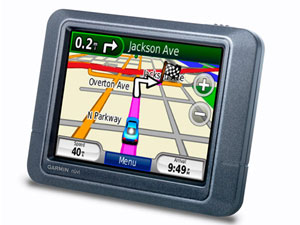I. Technical Background
– The GPS satellites were initially manufactured by Rockwell; the first was launched in February, 1978, and the most recent was launched November 6, 2004.
Each satellite circles the Earth twice every day at an altitude of 20,200 kilometres (12,600 miles). The satellites carry atomic clocks and constantly broadcast the precise time according to their own clock, along with administrative information including the orbital elements of their own motion, as determined by a set of ground-based observatories.
The receiver does not need a precise clock, but does need to have a clock with good short-term stability and receive signals from four satellites in order to find its own latitude, longitude, elevation, and the precise time.
II.Company Profile
– Global positioning system is a satellite based navigation system which was started in 1973. GPS applications include surveing, space navigation, automatic vehicle monitoring, emergency services dispatching, and mapping and geographic information sstem geo referencing. At present thre are 32 GPS satellites reolving around the globe.
III. Significance and Purpose
Global Positioning System has numerous applications. The earliest application was military. Boaters were the first civilians to use GPS extensively for navigation, as dead reckoning is prone to error. Many high-end cars have a GPS navigation system which serves much the same purpose as a marine GPS. Some athletes are turning to GPS to track speed and distance. A few digital cameras have a GPS receiver which records the location where the picture was taken. So far, I’ve listed only one-way applications. Two-way applications include cell phones when calling the emergency number and vehicle tracking.
IV. Conceptual Development and Implementation
– In 1956, the German-American physicist Friedwardt Winterberg proposed a test of general relativity (for time slowing in a strong gravitationalfield) using accurate atomic clocks placed in orbit inside artificial satellites. (Later, calculations using general relativity determined that the clocks on GPS satellites would be seen by Earth’s observers to run 38 microseconds faster per day, and this was corrected for in the design of GPS.
The Soviet Union launched the first man-made satellite, Sputnik, in 1957. Two American physicists, William Guier and George Weiffenbach, at Johns Hopkins’s Applied Physics Laboratory (APL), decided to monitor Sputnik’s radio transmissions. Within hours they realized that, because of the Doppler effect, they could pinpoint where the satellite was along its orbit.
V. Quality Attributes
Reliability
– The aim of this study was to assess the accuracy and reliability of global positioning system (GPS) measures of distance and speed, compared to a high-resolution motion analysis system, for confined movement patterns used in many court-based sports.
Performance
The levels of performance that the user can expect from GPS are specified in the Standard Positioning Service Performance Standard, and the Precise Positioning Service Standard. However, the values provided by these documents are very conservative, being the actual performances usually better than these official values.
Moreover, the performance obtained with GPS depends strongly on the mode of operation. For instance, a stand-alone receiver that uses only the signals received from the satellites, the levels of performance are:
- C/A-code receivers ~ 5 -10 m.
- P/Y-code receivers ~ 2 -9 m
In case of using GPS in a differential mode, DGPS, the performances that can be expected are:
- C/A-code DGPS receivers ~0.7 -3 m.
- P/Y-code DGPS receivers ~0.5 -2.0 m.
Security
– GPS was created to give an international standard security service in Bali. We specialize in providing security management for your business, property, and event and have access to the necessary facilities to provide VVIP services for clients that require secure transportation in & around Bali.
VI.Possible problems
– If your GPS unit or others’ GPS units are leading people to an incorrect address OR are otherwise leading people to an incorrect location, the problem is not likely a “GPS” problem, but rather, it is very likely a MAPPING problem.
Unfortunately, the Navigation Center cannot assist you with GPS unit mapping problems, as we do not develop, control, nor repair the mapping software contained in GPS units, including vehicle navigation systems. Please see our GPS mapping problems page for additional information.
VII. Design Specification
VIII. References
http://www.answers.com/Q/What_is_the_purpose_of_global_positioning_system


